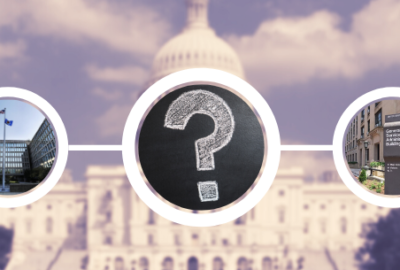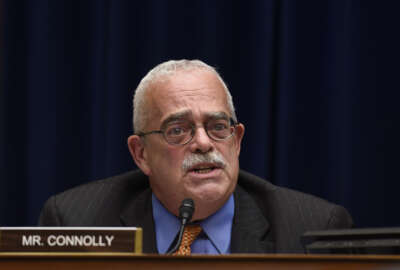

Nearly one year since the Trump administration first made its case to the public about its plan to merge the Office of Personnel Management with the General...
The Government Accountability Office went searching for more details and plans associated with the Trump administration’s proposed merger of the Office of Personnel Management with the General Services Administration.
But it came up mostly empty-handed.
Though OPM, GSA and Office of Management and Budget leadership did form working groups and met frequently to discuss the proposed merger, the plans, business cases and cost analyses they developed contained few actionable details, GAO said this week in a new report on the administration’s reorganization initiatives.
The review has been nearly a year in the making after GAO testified at a House Oversight and Reform Committee hearing on the OPM-GSA merger back in May 2019.
GAO at the time said neither OPM nor GSA had satisfied the best practices and planning requirements auditors usually look for when evaluating the viability of a major reorganization effort like this one.
One year later, the administration still hadn’t satisfied the vast majority of those best practices, GAO said.
OPM and GSA general counsel offices never provided a description of the legal authorities they believed they already had or needed to carry out pieces of the merger.
The two agencies did, according to GAO, consider the upfront costs that might be associated with the merger. But the agencies did not finalize specific metrics and targets associated with the moves.
“Major change initiatives should be based on either a clearly presented business case or analysis of costs and benefits grounded in accurate and reliable data, both of which can show stakeholders why a particular initiative is being considered and the range of alternatives considered,” GAO said. “While OPM officials had some information on the costs and benefits they planned to achieve by merging functions with other agencies, they did not have an analysis or underlying data supporting their conclusions.”
OPM did give GAO a description of its financial challenges, a qualitative business case and a list of other states and foreign countries that had an integrated administrative agency, as well as an estimate of the potential cost savings for the merger.
But the documents didn’t have specific, quantitative outcomes or metrics, GAO said.
Efforts to engage OPM employees and other stakeholders in reorganization planning also came up short.
“We found that OPM’s early outreach efforts to employees and stakeholders were insufficient, the agency did not have a plan for incorporating employee and stakeholder feedback, and it did not share relevant implementation details that may have affected employees and stakeholders,” GAO said.
OPM later provided GAO with a list of the calls, meetings and townhall discussions agency leaders held with employees, Congress and other stakeholders, but the events all began months after the merger plan had been related to the public.
Agency leaders were concerned about employee engagement, and then-acting OPM Director Margaret Weichert launched an internal survey to gauge morale. She shared the results of the survey and held listening sessions to discuss them with the workforce, GAO said.
“However, OPM officials did not determine how they planned to use these communications to sustain and strengthen employee engagement,” GAO said. “In November 2019, OMB staff told us that because they were still in the planning stages of the reorganization, the proposed reform had not yet involved major changes for employees, so they put employee engagement efforts on hold.”
Current and former OPM employees have previously told Federal News Network the merger proposal created uncertainty and fostered low morale within the agency.
In addition, none of the agencies ever explained how the merger would resolve longstanding management challenges — or why GSA was better equipped to handle OPM’s high-risk IT systems, GAO said.
“In November 2019, OMB staff told us that, because the proposed merger was a long-term effort and plans were still under development, they had not yet determined how our high-risk and other management challenges would be addressed,” the report reads.
Agency officials gave a similar response to explain why they hadn’t yet finalized a top-to-bottom implementation plan for the merger or a comprehensive plan for the OPM and GSA workforces.
GAO offered no specific recommendations for OPM, GSA or OMB, instead acknowledging the year-long, congressionally-mandated study the National Academy of Public Administration will conduct.
NAPA and OPM signed a contract back in mid-March, and the academy has chosen five fellows to serve on the study panel.
GAO’s assessment of OPM’s transfer of the National Background Investigations Bureau to the Pentagon was significantly more positive.
The Pentagon stood up a Personnel Vetting Transformation Office (PVTO), which was initially designed to oversee and implement the change management activities associated with the security clearance transfer. The office today is managing future changes to the broader clearance process.
“The PVTO director also showed us a detailed implementation plan organized around the nine functional areas identified in the broader joint transfer plan,” GAO said. “The implementation plan tracked thousands of activities and provided a detailed timeline for completion. The director also provided us a dashboard that his team used to track implementation progress. The director told us that his office used the dashboard to manage and monitor the transfer daily. The dashboard allowed the implementation team to identify areas where attention was needed using red, yellow, and green stoplight indicators signaling the status of major objectives.”
OPM and DoD managed to meet nearly all of GAO’s best practices for reorganization,
Some 2,979 NBIB employees successfully transferred to DoD’s pay and personnel system at the Oct. 1 deadline; 17 employees chose to retire.
NBIB officials told GAO they began townhall meetings with their employees as early as July 2017, when proposals to move portions of the bureau to the Pentagon were still under consideration in Congress.
OPM surveyed NBIB employees last April, ahead of the upcoming transfer to DoD in October. The goal, GAO said, was to collect information on employees’ perceptions of the transition to the Pentagon, their work experiences, job satisfaction and whether they intended to leave their positions.
Two-thirds of the NBIB workforce said they felt extremely informed to somewhat informed about the upcoming transfer. Another one-third said they didn’t feel informed at all.
“When asked about satisfaction with involvement with decisions that affect their work, 38% of respondents were positive, 34% were neutral, and 28% were negative,” GAO said.
Copyright © 2024 Federal News Network. All rights reserved. This website is not intended for users located within the European Economic Area.
Nicole Ogrysko is a reporter for Federal News Network focusing on the federal workforce and federal pay and benefits.
Follow @nogryskoWFED



